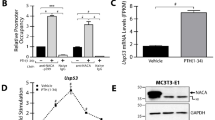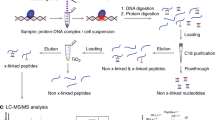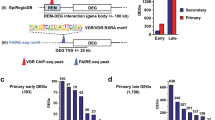Abstract
The vitamin D receptor (VDR) binds to specific DNA sequences termed vitamin D response elements (VDREs) thereby enhancing or repressing transcription. We have used electrospray ionization mass spectrometry to examine the interaction between the DMA-binding domain of the vitamin D receptor (VDR DBD) with a double-stranded DNA (dsDNA) sequence containing the VDRE from the mouse osteopontin gene. The VDR DBD was shown to bind to the appropriate DNA sequence only when bound to 2 moles of zinc (Zn2+) or cadmium (Cd2+) per mole of protein. Additional binding of Zn2+ or Cd2+ by the protein caused the protein to dissociate from the dsDNA. These results show that the VDR DBD/DNA metal-dependent association occurs when the receptor is occupied by 2 moles of Zn2+ per mole of protein and that further binding of Zn2+ to the protein causes dissociation of the complex.
This is a preview of subscription content, access via your institution
Access options
Subscribe to this journal
Receive 12 print issues and online access
$209.00 per year
only $17.42 per issue
Buy this article
- Purchase on Springer Link
- Instant access to full article PDF
Prices may be subject to local taxes which are calculated during checkout
Similar content being viewed by others
References
Darwish, H. and DeLuca, H.F. 1993. Vitamin D-regulated gene expression. Crit. Rev. Eukaryot. Gene Expr. 3:89–116.
Perret, C., Colnot, S., Romagnolo, B. and Thomasset, M. 1997. Control of nuclear transcription of vitamin D-dependent genes by vitamin D. Curr. Opin. Nephrol, Hypertens. 6:314–320.
Horseman, N.D., Engle, S.J. and Ralescu, A. 1997. The logic of signaling from the cell surface to the nucleus. Trends Endocrine Metabolism 8:123–129.
Beato, M. and Sanchez-Pacheco, A. 1996. Interaction of steroid hormone receptors with the transcription initiation complex. Endocr. Rev. 17:587–609.
Zilliacus, J., Wright, A.P., Carlstedt-Duke, J. and Gustafsson, J.A. 1995. Structural determinants of DNA-binding specificity by steroid receptors. Mol. Endocrinol. 9:389–400.
Freedman, L.P. and Luisi, B.F. 1993. on the mechanism of DNA binding by nuclear hormone receptors: a structural and functional perspective. J. Cell. Biochem. 51:140–150.
Ribeiro, R.C., Kushner, P.J. and Baxter, J.D. 1995. The nuclear hormone receptor gene superfamily. Annu. Rev. Med. 46:443–453.
Freedman, L.P., Luisi, B.F., Korszun, Z.R., Basavappa, R., Sigler, P.B. and Yamamoto, K.R. 1988. The function and structure of the metal coordination sites within the glucocorticoid receptor DNA binding domain. Nature 334:543–546.
Carlberg, C. 1995. Mechanisms of nuclear signaling by vitamin D3. Interplay with retinoid and thyroid hormone signaling. Eur. J. Biochem. 231:517–527.
Pike, J.W. 1991. Vitamin D3 receptors: structure and function in transcription Annu. Rev. Nutr. 11:189–216.
Freedman, L.P. and Towers, T.L. 1991. DNA binding properties of the vitamin D, receptor zinc finger region. Mol. Endocrinol. 5:1815–1826.
Carlberg, C., Bendik, I., Wyss, A., Meier, E., Sturzenbecker, L.J., Grippo, J.F. and Hunziker, W. 1993. Two nuclear signaling pathways for vitamin D. Nature 361:657–660.
Mangelsdorf, D.J., Thummel, C., Beato, M., Herrlich, P., Schutz, G., Umesono, K. et al. 1995. The nuclear receptor superfamily: the second decade. Cell 83:835–839.
Craig, T.A., Veenstra, T.D., Naylor, S., Tomlinson, A.J., Johnson, K.L., Macura, S. et al. 1997. Zinc binding properties of the DNA binding domain of the 1,25-dihy-droxy vitamin D3 receptor. Biochemistry 36:10482–10491.
Veenstra, T.D., Johnson, K.L., Tomlinson, A.J., Craig, T.A., Kumar, R. and Naylor, S. 1998. Zinc-induced conformational changes in the DNA-binding domain of the vitamin D receptor determined by electrospray ionization mass spectrometry. Journal of the American Society of Mass Spectrometry 9:8–14.
Fenn, J.B., Mann, M., Meng, C.K., Wong, S.F. and Whitehouse, C.M. 1990. Electrospray ionization for mass spectrometry of large biomolecules. Science 246:64–71.
Smith, R.D., Bruce, J.E., Wu, Q.Y. and Lei, Q.P. 1997. New mass spectrometric methods for the study of noncovalent associations of biopolymers. Chemical Society Reviews 26:191–202.
Wu, Q.Y., Gao, J.M., McCarthy, J.D., Sigal, G.B., Bruce, J.E., Whitesides, G.M. and Smith, R.D. 1997. Carbonic anhydrase-inhibitor binding- from solution to the gas phase. Journal of the American Chemical Society 119:1157–1158.
Cheng, X., Harms, A.C., Goudreau, P.N., Terwilliger, T.C. and Smith, R.D. 1996. Direct measurement of oligonucleotide binding stoichiometry of gene V protein by mass spectrometry. Proc. Natl. Acad. Sci. USA 93:7022–7027.
Loo, J.A. 1997. Studying noncovalent protein complexes by electrospray ionization mass spectrometry. Mass SpectrometryReview 16:1–23.
Nemirovskiy, O.V., Ramanathan, R. and Gross, M.L. 1997. Investigation of calcium-induced, noncovalent association of calmodulin with mellitin by electrospray ionization mass spectrometry. Journal of the American Society of Mass Spectrometry 8:809–812.
Loo, J.A., Hu, P.F., McConnell, P., Mueller, W.T., Sawyer, T.K. and Thanabal, V. 1997. A study of SRC SH2 domain protein-phosphopeptide binding interactions by electrospray ionization mass spectrometry. Journal of the American Society of Mass Spectrometry 8:234–243.
Potier, N., Barth, P., Tritsch, D., Biellmann, J.F. and Vandorsselaer, A. 1997. Study of non-covalent enzyme-inhibitor complexes of aldose reductase by electrospray mass spectrometry. Eur. J. Biochem. 243:274–282.
Haas, T.A. and Plow, E.F. 1996. The cytoplasmic domain of αllb β. A ternary complex of the integrin α and β subunits and a divalent cation. J. Biol. Chem. 271:6017–6026.
Veenstra, T.D., Johnson, K.L., Tomlinson, A.J., Naylor, S. and Kumar, R. 1997. Determination of calcium-binding sites in rat brain calbindin D28K by electrospray ionization mass spectrometry. Biochemistry 36:3535–3542.
Goodlett, D.R., Camp, D.G., Hardin, C.C., Corregan, M. and Smith, R.D. 1993. Direct observation of a DNA quadruplex by electrospray ionization mass spectrometry. Biological Mass Spectrometry 22:181–183.
Cheng, X., Morin, R.E., Harms, A.C., Bruce, J.E., Ben-David, Y. and Smith, R.D. 1996. Mass spectrometric characterization of sequence-specific complexes of DNA and transcription factor PU.1 DNA binding domain. Anal. Biochem. 239:35–40.
Sarkar, B. 1995. Metal replacement in DNA-binding zinc finger proteins and its relevance to mutagenicity and carcinogenicity through free radical generation. Nutrition 11:646–649.
Hanas, J.S. and Gunn, C.G. 1996. Inhibition of transcription factor IIIA-DNA interactions by xenobiotic metal ions. Nucl. Acids Res. 24:924–930.
Thiesen, H.J. and Bach, C. 1991. Transition metals modulate DNA-protein interactions of SP1 zinc finger domains with its cognate target site. Biochem. Biophys. Res. Commun. 176:551–557.
Berg, J.M. and Shi, Y. 1996. The galvanization of biology: a growing appreciation for the roles of zinc. Science 271:1081–1085.
Fleet, J.C., Turnbull, A.J., Bourcier, M. and Wood, R.J. 1993. D-sensitive and quinacrine-sensitive zinc transport in human intestinal cell line Caco-2. Am. J. Physiol. 264:G1037–G1045.
Reyes, J.G. 1996. Zinc transport in mammalian cells. Am. J. Physiol. 270:C401–C410.
Antoniou, L.D., Shalhoub, R.J. and Elliot, S. 1981. Zinc tolerance tests in chronic uremia. Clin. Nephrol. 16:181–187.
Kowarski, S., Blair-Stanek, C.S. and Schachter, D. 1974. Active transport of zinc and identification of zinc-binding protein in rat jejunal mucosa. Am. J. Physiol. 226:401–407.
Johnson, K.L., Veenstra, T.D., Tomlinson, A.J., Kumar, R. and Naylor, S. 1997. Determination of non-covalent metal ion/protein interactions using a microflow electrospray ionization mass spectrometry interface. Rapid Commun. Mass Spectrom. 11:939–942.
Author information
Authors and Affiliations
Corresponding authors
Rights and permissions
About this article
Cite this article
Veenstra, T., Benson, L., Craig, T. et al. Metal mediated sterol receptor-DNA complex association and dissociation determined by electrospray ionization mass spectrometry. Nat Biotechnol 16, 262–266 (1998). https://doi.org/10.1038/nbt0398-262
Received:
Accepted:
Issue Date:
DOI: https://doi.org/10.1038/nbt0398-262



